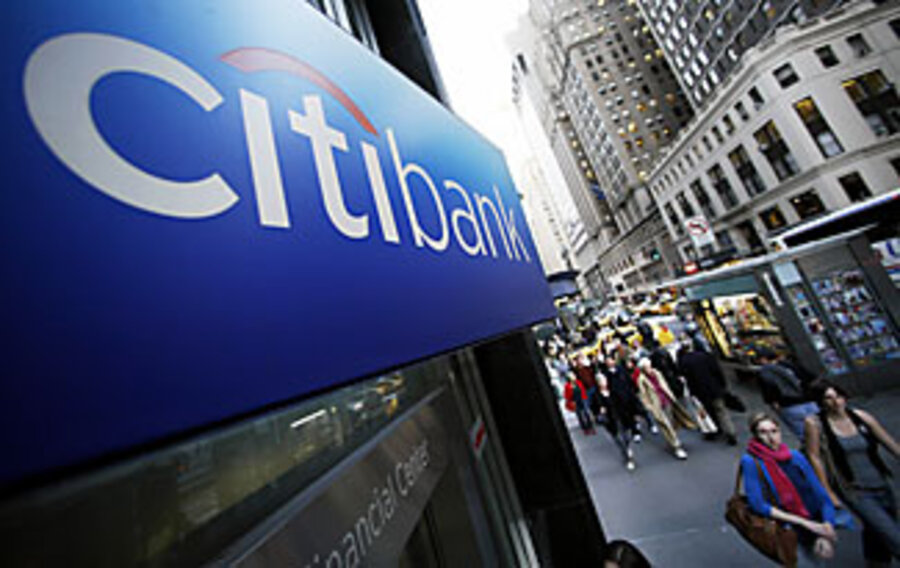A scramble to unlock bank lending
Loading...
| New York and baltimore
America runs on credit.
But the banking system, after writing off hundreds of billions of dollars in bad loans, is not in the mood or may not have the capacity to provide loans to everyone who deserves one.
So now regulators are weighing what steps to take next to unclog the banking system and kick-start the nation's loan officers into lending again to businesses, states, home buyers, and people who just want to buy a car.
Among the ideas: Use taxpayer dollars to buy stakes in troubled private banks, in a bid to strengthen the banks' balance sheets so they will be better positioned to lend. Another is for the Federal Reserve to expand its loanmaking to include mom and pop, not just large companies. Then there's the notion of changing US tax laws to allow the banks to get big refund checks from the Treasury.
"In a crisis no option is off the table," says Brian Bethune, chief US economist at Global Insight in Lexington, Mass. "Whether they ultimately have to do any of this is another matter."
All these suggestions come even after the Federal Reserve on Wednesday made an emergency interest-rate cut of half a percent, the world's central banks have flooded the financial markets with hundreds of billions of dollars, and Congress has passed a $700 billion bank rescue plan.
"What has happened is that all the credit managers have slammed on the brakes and the train has slowed to such an extent it is barely moving," Mr. Bethune says. "How do you get the train moving again?"
One way might be for the US Treasury to use some of the $700 billion authorized in the rescue plan as new capital for the banks, rather than buying at auction the troubled debt securities held by the banks.
"It's quicker if you do direct injection instead of buying troubled assets," says Lyle Gramley, a consulting economist at Stanford Washington Research Group and a former governor of the Federal Reserve.
Injecting capital directly into the banks also would give more heft to the money, says James Barth, a senior finance fellow at the Milken Institute in Santa Monica, Calif. "For every dollar of capital, you can lend multiple dollars, whereas when you buy up troubled assets, you do not increase capital," says Mr. Barth, a former bank regulator during the Reagan and Bush administrations.
There is precedent for the government (and, by extension, US taxpayers) in effect becoming a shareholder in private financial institutions in a bid to save them. "We did it during the bailout of the savings and loans in the 1980s, when the government took equity warrants in the institutions," he says.
It also happened during the takeover of the Continental Illinois Bank, then America's seventh largest, which failed in 1984 after making bad loans, says Doug Roberts of Channel Capital Research in Shrewsbury, N.J. The US government ultimately sold that investment to Bank of America and made money on it.
But not all analysts would agree that the time has come for the Treasury to burst the last boundary of market-based economics and pump taxpayer funds directly into private banks.
At the least, the move may be premature, given that the Treasury's $700 billion Troubled Asset Recovery Program is still in the planning stage, says J.D. Foster, a senior fellow in the economics of fiscal policy at the Heritage Foundation in Washington.
"I'm not convinced at this point. It seems to me that the tools they already have ... are adequate to get the markets functioning more normally," says Mr. Foster.
He fears that the pressure on Washington to begin making direct management decisions might become irresistible.
There's a phrase for that, and it isn't "free-market economics." It's "social democracy," the sort of government involvement with corporate economic policy that characterized much of Western Europe in the post-World War II period.
"We could out-France France with this," says Foster.
Some economists suggest there may be other ways to get credit to needy businesses.
Mr. Gramley, the former Federal Reserve governor, says the Fed could expand its program that makes loans directly to businesses. On Tuesday, the Fed announced it would buy commercial paper directly from large companies, the first time it has done that since the Great Depression.
"That's fine for businesses that can finance their needs in the commercial paper market," he says. But he says the Fed can set up a program to lend to smaller firms that need money, and it can use local commercial banks to funnel that money to the businesses. "If they are good loans normally, they would be good loans now, and it would break the logjam business is experiencing," he says.
Bethune of Global Insight suggests that banks no longer base their lending rates on the London Interbank Offer Rate (LIBOR), a global measure of lending rates. Banks formerly had based their lending on the prime interest rate – the rate they loaned to their best customers.
"The prime rate has been coming down, and [shifting away from LIBOR] removes us from the European banks and their problems," says Bethune.
Strangely, the data do not show loan growth slowing. As of Sept. 27, commercial and industrial loans and consumer loans were still growing, says Gramley.
But anecdotal reports since then indicate a serious problem, he adds.
"If we don't do something, the economy will go down the tubes," he warns. "In prior recessions, if the Fed hit the gas pedal hard, we would get out of recession. But that was when the credit markets were normal."





